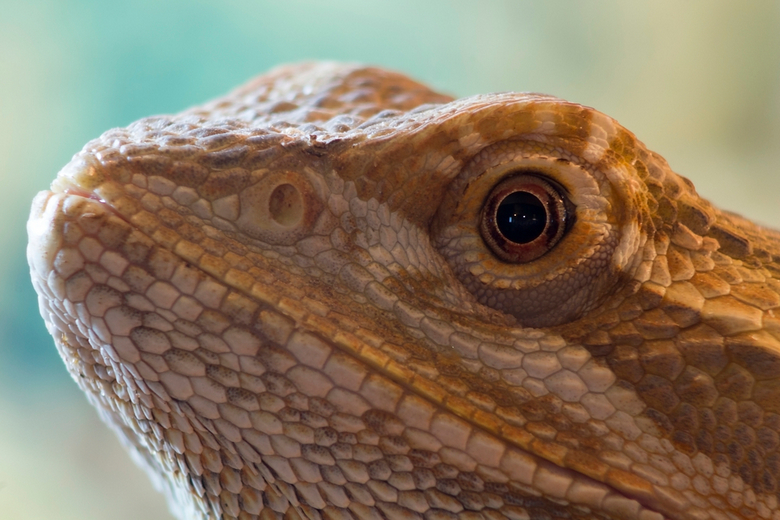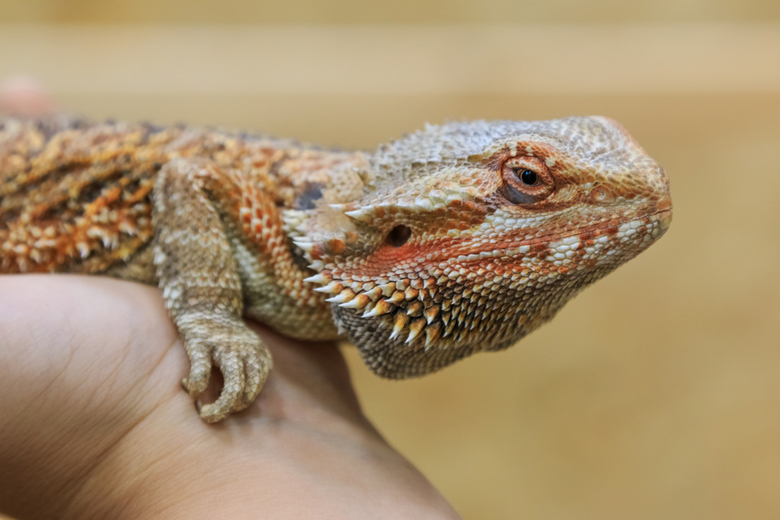Found in the deserts of Australia, the Pogona, is also fondly called the bearded dragon. It derives its name from its unique ability of flaring up its throat and erecting its spines when threatened - a natural defence mechanism.
Before you decide on whether or not to keep a bearded dragon as a pet, you would want to have a look at the pros and cons list that would help you make a good decision.

Pros for having a Bearded Dragon
Lifespan: They have long lives - Bearded dragons have a long life expectancy. An average bearded dragon is known to live up to 12 years. The average lifespans quoted are obviously dependent on how good their upbringing is and special care (in terms of its nutrition, environment monitoring and overall hygiene maintenance) must be taken by the owner to ensure the bearded dragon lives long.
Behaviour: They are known to be very friendly - Don’t fall for their intimidating looks, the bearded dragons are in reality really friendly. They are extremely mild mannered and enjoy human companionship. You can actually place it in your palm gently and let it rest there for long stretches of time. Its body does look far from docile when its throat is puffed out and the spines are erected; but rest easy, the bearded dragon is perhaps among the most harmless reptiles out there.
However do not keep two male bearded dragons together. They might fight and hurt each other.
Physical appearance: They are beautiful and can take up multiple shapes and morphs - Bearded dragons are available in multiple colours such as red, yellow, white, purple - and they have the ability to morph and exhibit more colours. Bearded dragons are a very exotic breed of reptiles, their origins being the selective desserts in Australia. Perhaps the most remarkable physical trait is its beard. The bearded dragon puffs out its beard and its spines stand up when it feels threatened (giving it that famous “bearded look”)
Weight: They are light-weighted. An average bearded dragon weighs only 500 grams and is thus easy to carry around, play with, or perhaps even taken to small picnics. But be careful, the bearded dragon is known to be very susceptible to bone diseases and can sustain injuries if it is subjected to external damages.
Silent creatures when left alone: They are disciplined and quiet. The bearded dragon is said to be very quiet and won’t disturb you under normal circumstances. If given the right environment and timely food, the reptile will stay reasonably happy and won’t bother you at all. However, it does enjoy human company and you might want to take out hours from your busy schedule to spend time with it!
Body odour: Bearded dragons are not smelly - unlike a few other reptiles, the bearded dragon does not smell. However, care must be taken to keep the dragon and its environment clean. This would include giving it regular baths, moistening its body, cleaning its faecal matter, and keeping its surrounding environment tidy. Keeping good hygiene is of paramount importance, and as long as you maintain a clean set-up, you need not worry.

Cons of having a Bearded Dragon
Health issues: They can be prone to various health problems. When bearded dragons are caught in the wild, it is fairly common for them to harbour certain diseases (bone related or viral) which will reduce their life expectancy.
Bearded dragons are known to have out of balance bone densities. They have a brittle bone structure and can develop fractures and other issues fairly easily. Also, it is not uncommon to see the bearded dragons suffer from respiratory infections. Holistically, excessive care should be given to the dragon to ensure that it stays fit.
Temperature adaptability: They are able to adapt to select temperature ranges only. The preferred temperature range is between 20 - 30 degrees. If the weather starts to get colder, the bearded dragon starts having trouble digesting food and is then more likely to fall sick. Make sure to check the temperature ranges of the area you reside in. Alternatively, you could keep them in a controlled environment like a cage and set-up the needed temperature environment (monitored with the help of a thermometer). But that would definitely need a large degree of physical and manual monitoring and hence quite a pain.
Diet needs: They need a very specific, wholesome diet. Bearded dragons are omnivores and need a very balanced diet to stay healthy. Proper care must be taken to ensure that they are given the right nutrition and this might be a challenging task for any owner. They should be fed a mix of vegetarian and non-vegetarian food to be at peak health. In non-vegetarian food, they can be fed pinky mice or insects like worms or, cockroaches. In the vegetarian part of the meal, the bearded dragon should be fed vegetables with a special focus on green leafy vegetables.
Special lighted environment: They require a controlled lighted environment. In addition to their range-bound temperature requirements, the bearded dragons need a UVA or UVB long fluorescent tube light in their habitat. The lighting should be present to ensure that it is as close to its natural environment as possible. The lighting also ensures that it gets the needed calcium to maintain a sound bone density ratio. That keeps it stronger and fitter.
Price: They are expensive to maintain. bearded dragons by themselves are not very expensive (cost around 25-50 USD) but the cost of maintaining one is pretty high. They need special attention and care. When it comes to their diet and creating controlled lighting environments, it does get a tad expensive. The required setup can cost anywhere in the range of 250-300 USD. So do make sure that you have enough time and money for your bearded dragon.
Well, this concludes our list of pros and cons. We hope that this helps you make a more informed decision regarding whether you should keep one as your pet.
Sources and further readings
- PetCoach, Bearded Dragon Species Profile: Habitat, Diet and Care
- ScienceDaily, Bearded dragons change color on different body parts for social signals and temperature regulation
- Human Ageing Genomic Resources, Central bearded dragon (Pogona vitticeps) longevity, ageing, and life history
- Bearded Dragons: The Essential Guide to Ownership & Care for Your Pet by Kate H Pellham (author) ( Find This Book )
- Bearded Dragons (Mini Encyclopedia Series) by Chris Mattison (Author) ( Find This Book )